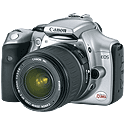
"Modified" Canon Digital Rebel 300D DSLR Camera

DSLR (Digital Single Lens Reflex) Cameras have changed how astrophotography is being done today. At one time, an astrophotographer had only one choice: a film based SLR camera attached to the telescope using a T-Ring adapter. Then digital cameras came about, but had 2 primary setbacks for astrophotography use: the lens could not be removed so as to attach the camera via a T-Ring adapter, and shutter speeds had little to no control needed to take long exposures. The DSLR solved both of those problems, and now an astrophotographer has a digital camera that can perform almost the same as its SLR counterpart.
My first DSLR camera was a Canon EOS 10D. It has the removable lens with a lens mount that can be used with a T-Ring adapter designed for the EOS mount. It was a 6.3 megapixel camera with a large 35mm film equivalent size imaging chip. It also supports manual control of shutter speeds, with a B (Bulb) setting that allows the camera to hold the shutter open for extremely long exposure times. I have taken several astrophotos with this camera. However, the camera does have a built-in IR filter which can not be removed without tearing into the camera and voiding the warranty. This IR filter blocks light frequencies that are needed to capture the full effects of many deep sky objects.
Procedures for removing the IR filter can be found on the Internet. I also use the Canon 10D for everyday photography, and removing the IR filter would mean that I would have to dedicate this camera to astrophotography only. Since Canon has introduced new lines of DSLR cameras, including the Canon 20D, 20Da (specifically designed for the astrophotography, but very pricey!) and the Canon Digital Rebel XT, used Canon Rebel 300D cameras have come down in price and are in abundant supply on the used market. The Canon Rebel 300D has the same imaging chip as the Canon 10D, and supports the EOS lens mount. It functions in much the same way as the 10D, but the camera housing is not quite as rugged as the 10D. Nevertheless, it seemed to make better sense to acquire a Rebel 300D and modify it to remove the IR filter than other alternatives.
I purchased a Rebel on eBay and sent it to Hap Griffin who offers a service of removing the IR filters from DSLR cameras. The results were superb!
Combined with software that can control the camera from a PC and you have a simple and very high performing astrophotography solution. For software, I use DSLR Focus and Guidedog. Capturing of the image can be done either to the CompactFlash card in the camera, or it can be downloaded directly to the PC or both. To download to the PC, all you need is a USB 2.0 compatible cable. To get shutter control of more than 30 seconds, you need to have a serial or parallel cable from the PC to the camera's external remote plug. Please see Hap Griffin for remote control cables as well.
The camera connects to my Taurus-Tech Tracker III flip mirror system through a T-Ring adapter designed to connect an SLR camera with the Tracker III.
Return to Telescope and Equipment page
Return to Dale's Astronomy Page
This page was last updated on 09/24/2005